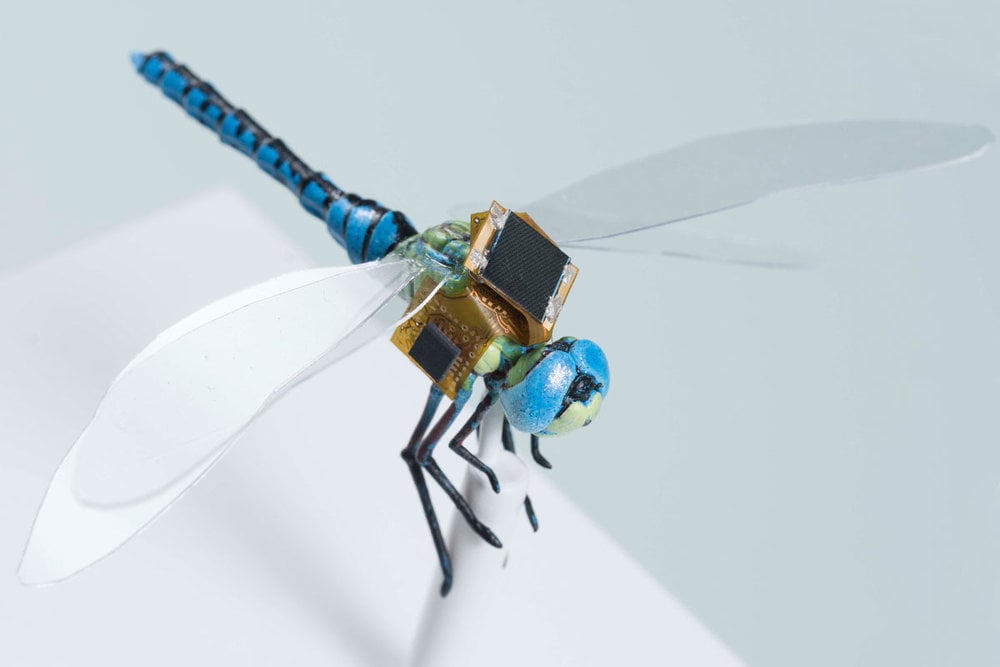
“DragonflEye” project is turning insects into cyborg drones
“R&D company Draper is developing an insect control “backpack” with integrated energy, guidance, and navigation systems, shown here on a to-scale dragonfly model.
To steer the dragonflies, the engineers are developing a way of genetically modifying the nervous system of the insects so they can respond to pulses of light. Once they get it to work, this approach, known as optogenetic stimulation, could enable dragonflies to carry payloads or conduct surveillance…”
Pentagon successfully tests micro-drone swarm
“The Pentagon may soon be unleashing a 21st-century version of locusts on its adversaries after officials on Monday said it had successfully tested a swarm of 103 micro-drones.
The important step in the development of new autonomous weapon systems was made possible by improvements in artificial intelligence, holding open the possibility that groups of small robots could act together under human direction.
Military strategists have high hopes for such drone swarms that would be cheap to produce and able to overwhelm opponents’ defenses with their great numbers.
The test of the world’s largest micro-drone swarm in California in October included 103 Perdix micro-drones measuring around six inches (16 centimeters) launched from three F/A-18 Super Hornet fighter jets, the Pentagon said in a statement.
“The micro-drones demonstrated advanced swarm behaviors such as collective decision-making, adaptive formation flying and self-healing,” it said.
“Perdix are not pre-programmed synchronized individuals, they are a collective organism, sharing one distributed brain for decision-making and adapting to each other like swarms in nature,” said William Roper, director of the Pentagon’s Strategic Capabilities Office. “Because every Perdix communicates and collaborates with every other Perdix, the swarm has no leader and can gracefully adapt to drones entering or exiting the team.”
Defense Secretary Ash Carter—a technophile and former Harvard professor—created the SCO when he was deputy defense secretary in 2012.
The department is tasked with accelerating the integration of technological innovations into the US weaponry.
It particularly strives to marry already existing commercial technology—in this case micro-drones and artificial intelligence software—in the design of new weapons.
Originally created by engineering students from the Massachusetts Institute of Technology in 2013 and continuously improved since, Perdix drones draw “inspiration from the commercial smartphone industry,” the Pentagon said.”
Controlling the minds of cockroaches using Microsoft’s Xbox Kinect
“Late last year, you were introduced to real, live, remote-controlled cockroaches. Well, the insect hackers at the North Carolina State University are at it again, this time with a Microsoft Kinect and a software program that can boss the bugs around without human input. In other words, we have successfully co-opted cockroach sovereignty — and given it to the machines.
The goal is to ultimately use this kind of technology to create armies of biobots capable of things bio-inspired robots can only dream of.
Now, instead of those impulses being controlled remotely by a human, they’re tapped into the software program, which takes cues from the Xbox Kinect’s tracking data. If the cockroach veers away from the target, the Kinect observes the change and relays it to the software, which in turn makes a split-second decision about how much correctional impulse should be sent to the roach. Longer stimulation is designed to produce more drastic correction, just like pulling hard on a steering wheel.
The results are pretty impressive. Their previous work with remote control yielded only about a 10 per cent success rate, but the new technology has bumped them up to 27 per cent. You can see it for yourself below with a roach that really seems to want nothing in the world but to turn right.”
Japan researchers warn of fingerprint theft from ‘peace’ sign, selfies
“Could flashing the “peace” sign in photos lead to fingerprint data being stolen? Research by a team at Japan’s National Institute of Informatics (NII) says so, raising alarm bells over the popular two-fingered pose. Fingerprint recognition technology is becoming widely available to verify identities, such as when logging on to smartphones, tablets and laptop computers. But the proliferation of mobile devices with high-quality cameras and social media sites where photographs can be easily posted is raising the risk of personal information being leaked, reports said. The NII researchers were able to copy fingerprints based on photos taken by a digital camera three meters (nine feet) away from the subject.”
